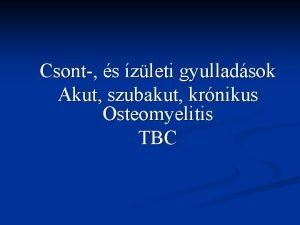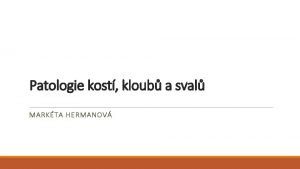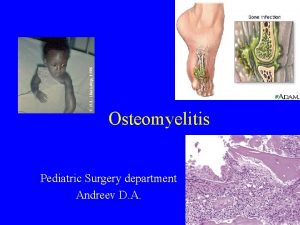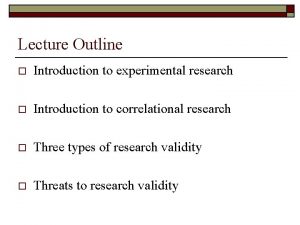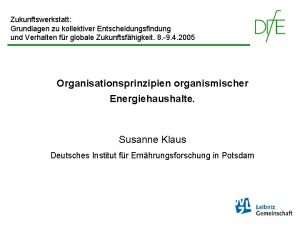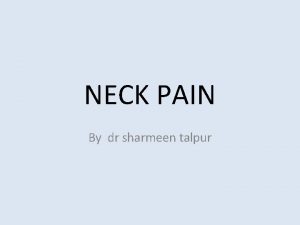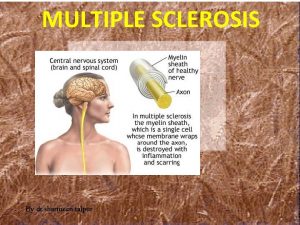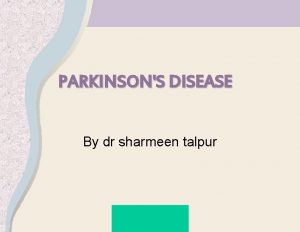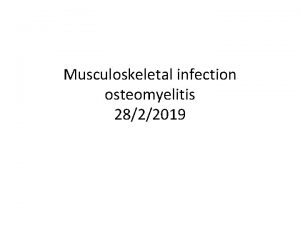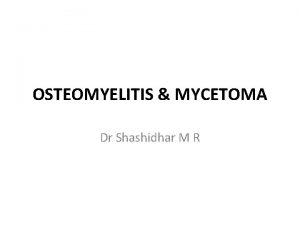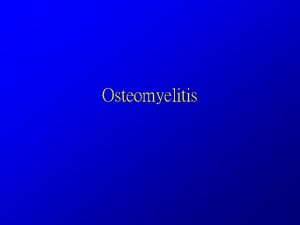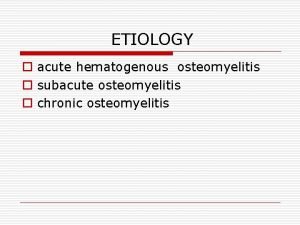Osteomyelitis Dr sharmeen talpur Definition Osteomyelitis is an










- Slides: 10

Osteomyelitis Dr. sharmeen talpur

Definition • Osteomyelitis is an infection of the bone by one of three modes: – Extension of soft tissue infection from pressure ulcer or incision. – Direct bone contamination from bone surgery, open fracture, or traumatic injury. – Bloodborne infection spread from other sites like tonsils, infected teeth, and upper respiratory infections). • Patients who are at high risk for osteomyelitis include those who are poorly nourished, elderly, or obese, those with impaired immune system, those with diabetes, rheumatoid arthritis, and those receiving long-term corticosteroid therapy. and sickle cell disease. 2

Pathophysiology • Staphylococcus aureus causes 70% to 80% of bone infections. Other pathogens found in osteomyelitis include Proteus, Pseudomonas species, Escherichia coli. , and penicillinresistant, nosocomial, gram-negative infections and mycobacterium tuberculosis. • The initial response to infection is inflammation, increased vascularity, and edema. After 2 or 3 days, thrombosis of the blood vessels occurs in the area, resulting in ischemia with bone necrosis. Unless the infective process is treated promptly, a bone abscess forms. 3

Clinical Manifestations • When the infection is bloodborne, the onset is usually sudden, occurring often with chills, high fever, rapid pulse, general malaise. As the infection progresses, the infected area becomes painful, swollen, and extremely tender. When osteomyelitis results from adjacent infection or from direct contamination, the area is swollen, warm, painful, and tender to touch. 4

5

Assessment and Diagnostic Findings • In acute osteomyelitis, early x-ray findings demonstrate soft tissue swelling. Radioisotope bone scans and MRI help with early definitive diagnosis. • Blood studies show leukocytosis and high erythrocyte sedimentation rate (ESR). Wound and blood culture studies are performed to identify appropriate antibiotic therapy. • With chronic osteomyelitis, dense bone formations are seen on x-ray. Bone scans may be performed to identify areas of infection. ESR and WBC count are usually normal. 6

Medical Management • Medical Management aims to control and halt the infective process, through IV antibiotic therapy (penicillin or cephalosporin) for 3 – 6 weeks based on the results of blood and wound cultures. After achieving infection control, the antibiotic may be administered orally for up to 3 months. • General supportive measures (eg, hydration, diet high in vitamins and protein, correction of anemia) should be instituted. • The area affected with osteomyelitis is immobilized to decrease discomfort and to prevent pathologic fracture of the weakened bone. Warm wet soaks for 20 minutes several times a day may be prescribed to increase circulation. 7

Nursing Management of a Patient With Osteomyelitis • Nursing Interventions. – Relief of pain. • Immobilise the affected part with a splint to decrease pain. • Monitor the neurovascular status of the affected extremity. • Elevate the affected part to reduce swelling and associated discomfort. • Administer analgesics as prescribed. – Improving physical mobility. • The bone is weakened by the infective process and must be protected by immobilization devices and by avoidance of stress on the bone. 8

Nursing Management of a Patient With Osteomyelitis • Nursing Interventions (Continued…). – Control and eradication of infection. • Monitor the patient’s response to antibiotic therapy. • Observe the IV access site for evidence of infection, . • With long-term, intensive antibiotic therapy, monitor the patient for signs of superinfection (eg, oral or vaginal candidiasis, loose or foul-smelling stools). • Monitor the general health and nutrition of the patient. A diet high in protein and vitamin C promotes healing. • Encourage adequate hydration. 9

Nursing Management of a Patient With Osteomyelitis • Nursing Interventions. – Knowledge of treatment regimen. • Teach the patient and family the importance of strictly adhering to therapeutic regimen of antibiotics and preventing falls or other injuries that could result in bone fracture. • Teach the patient how to maintain and manage the IV access and IV administration equipment in the home. • Provide information on medication education. 10

